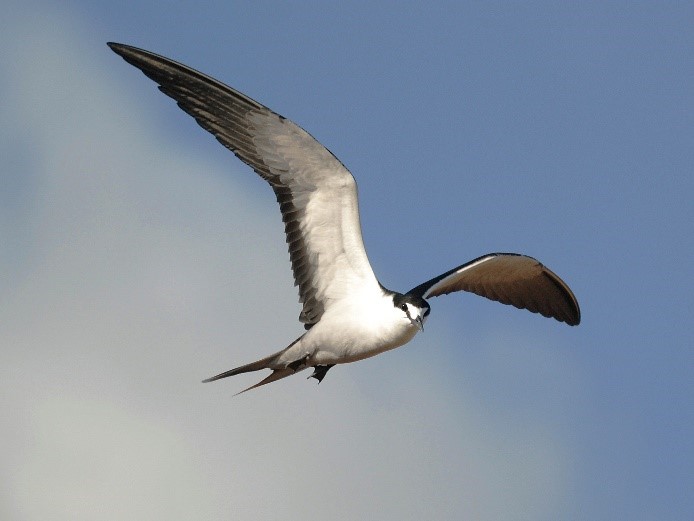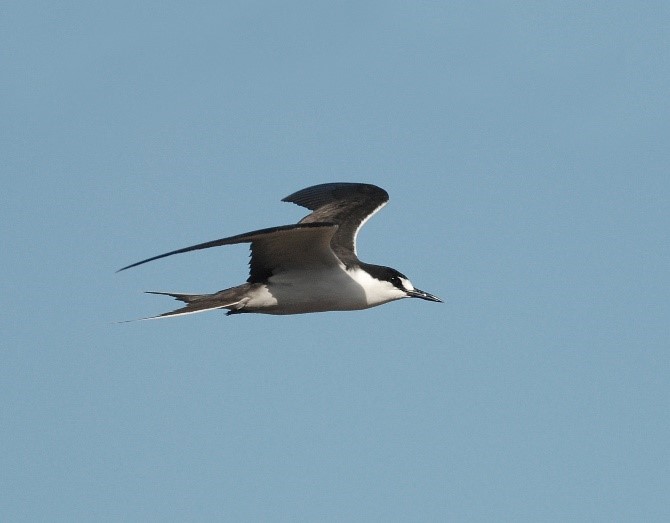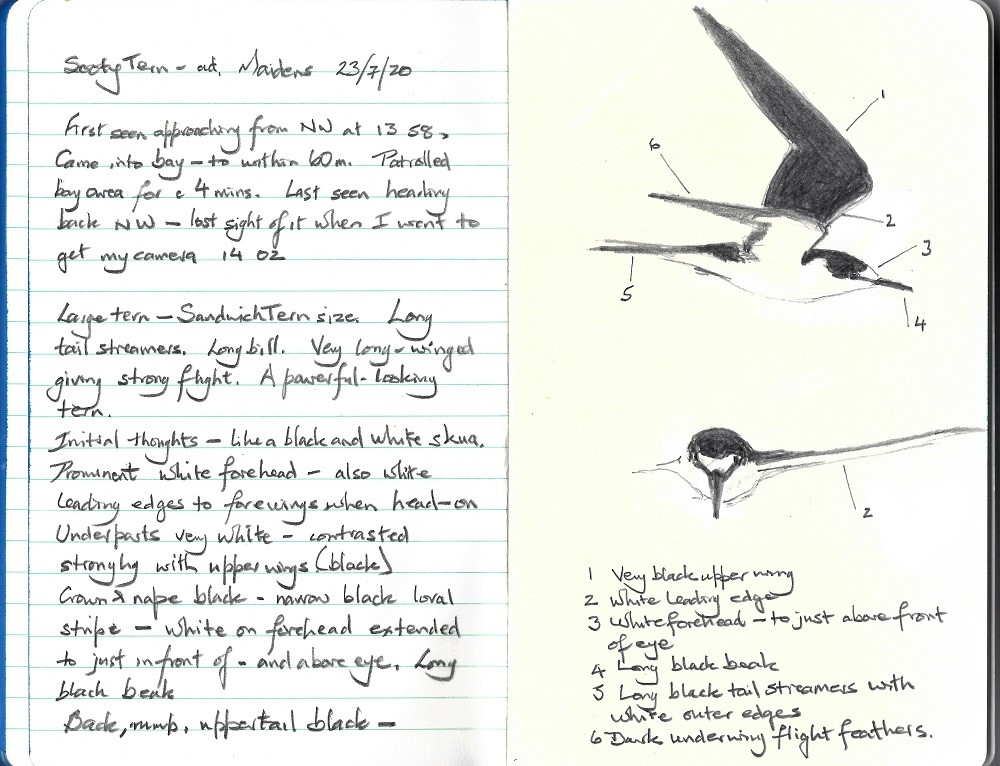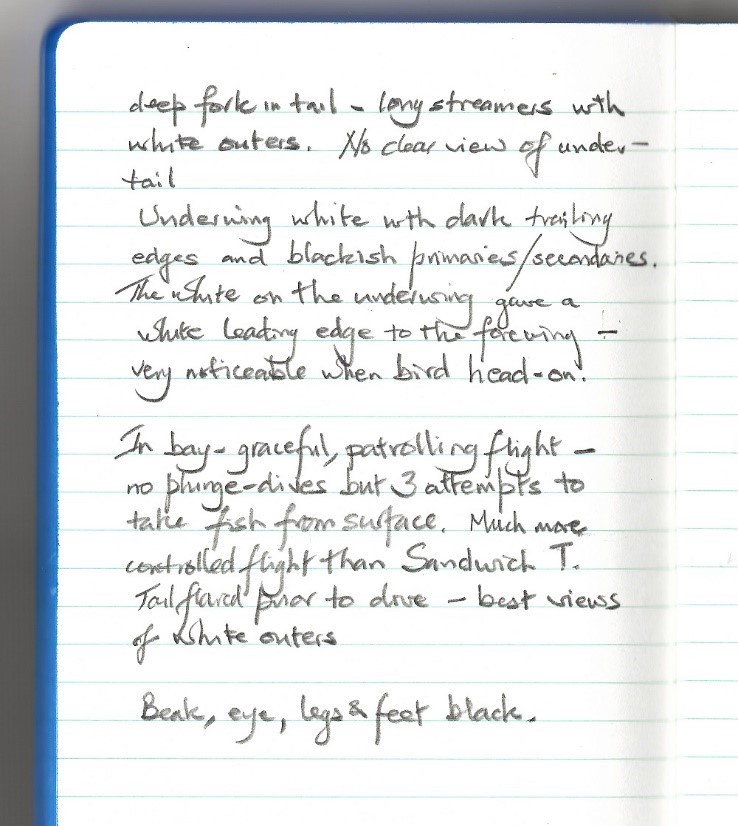
A sunny afternoon on the 23rd July 2020. I decide to take a trip down to Maidens harbour. Recurrent thoughts running through my head kept coming back to “What are you doing? You know it’s going to be full of tourists, and there’ll be no birds!” Arriving at the harbour, I rigged up my ‘scope on the tripod, and proceeded to look across the bay towards the north.
Predictably, the beach was full of people enjoying the sunshine, and there was not a bird to be seen on land. A few gulls on the sea, a couple of Sandwich Terns and…………………. what the hell is that!!?? At the north end of Maidenhead Bay, just south of Barwhin Point, I could see this tern-like seabird (or maybe it was skua?), flying along the bay, just a few metres from the shoreline. It was coming towards me, so my initial response was “Don’t lose it!” By the time it had flown about halfway down the bay, I had dismissed skua and was now thinking tern, but barely able to believe that it was what I thought it was.
Cursing the fact that a) I wasn’t on the beach where the bulk of holidaymakers were and b) that my camera was in the car, I had no option but to hope that it would continue on its path towards me. It must have only taken seconds, but it seemed like an eternity before it crossed over the stone pier which lies just east of the harbour. At this point the bird was only about 60 metres away and my hopes had been confirmed – it was an adult Sooty Tern.
At this point, it turned and made its way back into Maidenhead Bay, where it briefly tried its hand at fishing before flying north, then north west. Hoping that the bird would stay in the bay, I went to the car and grabbed my camera but, as usually happens in such cases, the bird simply vanished out to sea and was not seen again. Four minutes of sheer elation – these days don’t happen too often, but you certainly remember them for a long time!
Following this, I wrote up some notes and put some sketches into my notebook, before looking at any field-guides. This is a fairly spectacular oceanic tern which breeds in some huge colonies at places such as Ascension in the mid-Atlantic.

The plumage is quite distinctive, but it’s important to get a good view of the area in front of and just above the eye to completely eliminate Bridled Tern. I’ve attached extracts from my notes below which might act as a guide to the kind of detail required when submitting notes to the relevant assessment bodies.
Sooty Tern Description
General: size, shape, structure, flight etc
When the bird was first seen, I initially thought that it was a skua, this in part being due to its sleek, long-winged appearance and deep, powerful wingbeats. However, realising, as it came closer, that its plumage was just black and white, I dismissed that idea, and began to consider other options, particularly the oceanic terns. Amongst its most obvious features were its tern-like appearance with long wings, a fairly robust body, a deeply forked tail and a seemingly effortless flight action. At one point, it passed close to a Sandwich Tern which was actively fishing in the bay, and the overall size appeared similar – if anything the longer tail streamers made it look very slightly larger than the Sandwich Tern.
As it approached closer, the powerful and buoyant flight had narrowed my choices to what I thought were the most likely species i.e. Sooty or Bridled Tern. Although my leanings were towards the former, I made careful note of what I could remember as the important “separating” features. Fortunately, it did come reasonably close before turning back into the bay, allowing me to have a good look at it. On turning back into the bay, it appeared to hesitate, before swooping down towards the surface of the sea and make an attempt to pick something from it – an action which was not totally unlike that of a hawking marsh tern. It then circled and repeated this surface feeding technique, quite different from the Sandwich Tern nearby which was plunge-diving.
The immediate stop before the swoop to the sea surface was accompanied by a spreading of the tail which provided better views of the full set of tail steamers. After about 2 minutes of fishing, it resumed its strong, purposeful flight, and headed back up the bay towards the NW, at which point I lost track of it. After the bird left, and I realised that it was finally gone, I spent the next 5 minutes or so scanning the area and then phoned one or two friends to put the message out. Following that, I put down some notes and sketches in my notebook (attached).
Plumage
Overall
A big black and white tern, of a similar size to Sandwich Tern, with black upperparts and gleaming white underparts. The only parts which were different in tone were the trailing edges (flight feathers) of the undersides of the wings which were very dark – “blackish” – in appearance.
Head
A black cap extended from the rear of the forehead on to the nape, extending down to, and behind the eye, and was the same shade as the rest of the upperparts. A white forehead patch was very clearly evident, and this extended to just in front of and above the eye, but did not run further back than the front top edge of the eye. There was a black loral line running from the eye to the beak. The beak was long (for a tern) and black, and the eye appeared to be black. The lower parts of the face below the black cap, were bright white.
Underbody
Gleaming white – the contrast with the black upperparts could not have been greater, with the sunlight making it even more stunning.
Back, upper-wings and upper-tail
The back, mantle, rump and upper-tail surfaces were black with no variation in tone. The black on the hindneck/nape area connected with the black of the back. The upper-wing surfaces were also black, with the leading edges of the forewings showing white. This white “border” was surprisingly obvious, even at some distance, and particularly evident as the bird was flying towards me. It readily caught the sunlight and illuminated the leading edge of the inner wing area.
The upper-tail was also black, apart from white outer edges, which were particularly evident when the bird was fishing and spread its tail prior to swooping down to the sea surface. The white on the outer part of the tail feathers could also be seen in normal flight but were not as obvious.
The underwings were also white apart from the flight feathers which showed dark, blackish, making a sharp contrast with the rest of the underwing. This darker area included the whole area of the primaries, and secondaries extending this dark rear edge of the wing towards its root. The undertail and vent areas were not so well seen, the vent appearing much the same white tone as the rest of the underbody. The legs and feet were black.
The bird did not call during the observation period.
Notes and Sketches


Angus Hogg
11 Kirkmichael Road,
Crosshill, Maybole
Ayrshire
KA19 7RJ